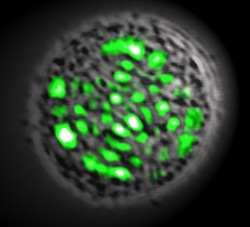Researchers develop laser using a living cell

Scientists have created a laser using a living cell for the first time.

Scientists have created a laser using a living cell for the first time. Image via SmartPlanet
Researchers used a single human kidney cell, a bit of jellyfish protein, a couple of mirrors and blue light in the experiment. A typical laser has a "gain medium" — a material that amplifies light given off by another source — and an "optical cavity" — mirrors set up in a way that lines up the light waves. When the outside source of light is trained on the gain medium, its atoms become excited and release photons.
As the photons ricochet between the mirrors, passing through the gain medium over and over again, they stimulate other atoms to release more photons. While the photons would normally exit in random directions the way light comes out of a torch, the mirrors direct the wavelengths into one beam, forming a laser.
In this case, the researchers made their gain medium out of the jellyfish protein — green fluorescent protein (GFP) — which is what makes jellyfish bioluminescent and is widely used in cell biology to label cells. They then engineered human embryonic kidney cells to produce GFP, and placed one such cell between two mirrors.
For more on this ZDNet UK-selected story, see Scientists turn living cell into laser on SmartPlanet.
Get the latest technology news and analysis, blogs and reviews delivered directly to your inbox with ZDNet UK's newsletters.